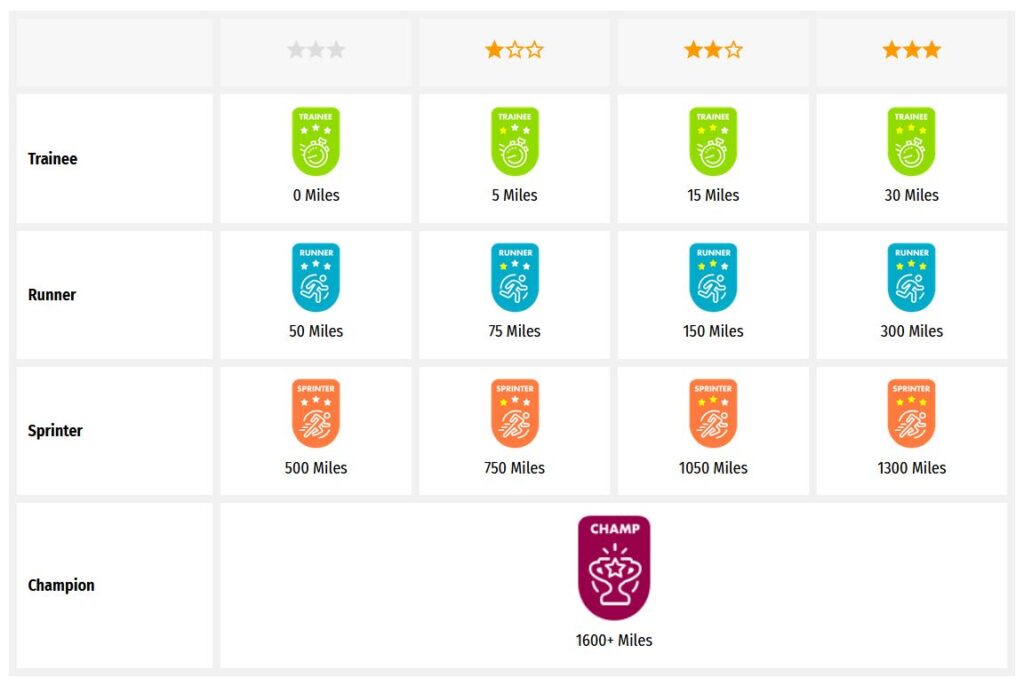Someone else is currently editing this document
Only one person can work on a document at a time
Frontiersmen Item 5
TRANSCRIPTION
are towed to primitive jetties, alongside which lies the goods yard of the Uganda Railway. Judging by the size of this goods yard it is evident that a large amount of traffic is handled at this port; as further evidence, in addition to the "Comrie Castle" there were five other large vessels stood off in the river taking in and putting off cargo, all of course by black labour.
Our draft did not actually go ashore until the Monday morning. Once ashore we were very busily engaged in getting things ready for our departure into the interior and commenced our journey by train early in the afternoon. The scenery through which we passed for the first two or three hours is quite beyond description to anyone but a gifted writer, the nearest comparison I can give being the Lake District in England, but the mountains at the mouth of the Maumandi River, which forms itself into a number of large lakes, are much higher and more majestic than those in the Lake District. Gradually the line began to ascend and we eventually lost sight of the river and lakes. At 5.30 we stopped for about an hour at a little wayside station, where we were made a very good tea of biscuits and jam. After tea it quickly drew dark and we continued our journey until 11.30 pm when we reached a large railway junction, where we were able to obtain tea, coffee and buns from the YMCA hut on the station. When we had had our refreshments the train was put into a siding and we endeavored to snatch a little sleep before continuing our journey. At five o'clock the following morning we set off again, eventually reaching our base camp at 10.30 the same morning; then commenced the task of pitching our camp and we were very busily engaged until dusk, by which time we had got things into shipshape order and were ready for a good night's rest. Our tents were mostly of the bivouac style, each accomodating eight to ten men; each man was served out with a ground sheet and a good blanket and for the first time in the experience of most, had to sleep on the ground; this did not inconvenience me personally as I had slept on the deck all the way from England, with the exception of one or two wet nights.
Our base camp was situated on the highest portion of the Mbuni Plain, a district well known to big-game hunters, where I am told President Roosevelt commenced his famous big-game expedition some years ago. Above and to the north of the camp is a wood at the top of which are two small hills; on the east is a magnificent range of mountains which make a very impressive picture, the colour of them seeming to vary so wonderfully in the different lights that play upon them at different times of the day. Away to the south, twenty to thirty miles over the plain another mountain range stretches; the plain between the mountains and the camp is so vast that it looks more like the sea, being at times quite blue in appearance. To the west is another range, behind which to the north west can occasionally be seen the snow-
capped peak of Mount Kilimanjaro, the highest mountain in Africa; it is about forty miles distant and is usually seen to best advantage at sunrise.
At this camp we had a very good time indded, and did not find it unduly hot as it is at a higher altitude; in fact, the weather while we were there was very much like what we get in England in September - not too hot during the day, and just a slight nip in the air at night. Before breakfast we usually had half an hour's Swedish Drill, then after breakfast about an hours drill on the parade ground; apart from occasional fatigues and guards this constituted the day's work. In place of the Swedish Drill many men had to do fatigues in connection with the cook-house - fetching fuel, water, rations and so forth. The most popular fatigue was that of fetching in the timber, a party of about two dozen men, of which I was one, set off into the wood armed with axes and cross-cut saws and cut down suitable trees which we carried or dragged back to the camp.
5
Language(s) of Transcription
LOCATION
German East Africa (-5.15428, 38.4495)
Story Location
ABOUT THIS DOCUMENT
Document Date
Document Type
Document Description
Language of Description
Keywords
External Web Resources
People
STORY INFORMATION
Title
Frontiersmen
Source
UGC
Contributor
europeana19141918:agent/febba033d0165f8943e27f84ae565abe
Date
1916-12
1916-08-14
Type
Story
Language
eng
English
Country
Europe
DataProvider
Europeana 1914-1918
Provider
Europeana 1914-1918
Rights
http://creativecommons.org/publicdomain/zero/1.0/ http://creativecommons.org/licenses/by-sa/3.0/DatasetName
2020601_Ag_ErsterWeltkrieg_EU
Begin
1916-08-14
End
1916-12
Language
mul
Agent
Alvin Whiteley | europeana19141918:agent/b59698da79c1c9883c8cc421f37f64e6
James Burnett Hewitt | europeana19141918:agent/febba033d0165f8943e27f84ae565abe
Created
2019-09-11T08:46:13.152Z
2020-02-25T08:54:27.488Z
2012-08-31 15:26:31 UTC
2012-08-31 15:27:06 UTC
2012-08-31 15:27:07 UTC
Provenance
INTERNET
Story Description
A prose account by Private Alvin Whiteley 41739 of his time in The Frontiersmen (25th Batt. Royal Fusiliers), travelling by ship to Africa and his service there, 1916. The journey to Africa is described in detail, as well as the life of a soldier (the language reflects the period) at Korogwe, at Maktau, at Gaveta in German East Africa. This campaign of the Legion of Frontiersmen was covered in the book The Battle for the Bundu and Alvin appears as the private who played the piano in the Officers Mess and one of the two thousand sent home with dysentery/malaria in one particular month.Transcript by James Hewitt of a prose account by Alvin Whiteley of his time in The Frontiersmen (25th Batt. Royal Fusiliers)
TRANSCRIPTION
LOCATION
DESCRIPTION
PEOPLE
STORY INFO
TUTORIAL
are towed to primitive jetties, alongside which lies the goods yard of the Uganda Railway. Judging by the size of this goods yard it is evident that a large amount of traffic is handled at this port; as further evidence, in addition to the "Comrie Castle" there were five other large vessels stood off in the river taking in and putting off cargo, all of course by black labour.
Our draft did not actually go ashore until the Monday morning. Once ashore we were very busily engaged in getting things ready for our departure into the interior and commenced our journey by train early in the afternoon. The scenery through which we passed for the first two or three hours is quite beyond description to anyone but a gifted writer, the nearest comparison I can give being the Lake District in England, but the mountains at the mouth of the Maumandi River, which forms itself into a number of large lakes, are much higher and more majestic than those in the Lake District. Gradually the line began to ascend and we eventually lost sight of the river and lakes. At 5.30 we stopped for about an hour at a little wayside station, where we were made a very good tea of biscuits and jam. After tea it quickly drew dark and we continued our journey until 11.30 pm when we reached a large railway junction, where we were able to obtain tea, coffee and buns from the YMCA hut on the station. When we had had our refreshments the train was put into a siding and we endeavored to snatch a little sleep before continuing our journey. At five o'clock the following morning we set off again, eventually reaching our base camp at 10.30 the same morning; then commenced the task of pitching our camp and we were very busily engaged until dusk, by which time we had got things into shipshape order and were ready for a good night's rest. Our tents were mostly of the bivouac style, each accomodating eight to ten men; each man was served out with a ground sheet and a good blanket and for the first time in the experience of most, had to sleep on the ground; this did not inconvenience me personally as I had slept on the deck all the way from England, with the exception of one or two wet nights.
Our base camp was situated on the highest portion of the Mbuni Plain, a district well known to big-game hunters, where I am told President Roosevelt commenced his famous big-game expedition some years ago. Above and to the north of the camp is a wood at the top of which are two small hills; on the east is a magnificent range of mountains which make a very impressive picture, the colour of them seeming to vary so wonderfully in the different lights that play upon them at different times of the day. Away to the south, twenty to thirty miles over the plain another mountain range stretches; the plain between the mountains and the camp is so vast that it looks more like the sea, being at times quite blue in appearance. To the west is another range, behind which to the north west can occasionally be seen the snow-
capped peak of Mount Kilimanjaro, the highest mountain in Africa; it is about forty miles distant and is usually seen to best advantage at sunrise.
At this camp we had a very good time indded, and did not find it unduly hot as it is at a higher altitude; in fact, the weather while we were there was very much like what we get in England in September - not too hot during the day, and just a slight nip in the air at night. Before breakfast we usually had half an hour's Swedish Drill, then after breakfast about an hours drill on the parade ground; apart from occasional fatigues and guards this constituted the day's work. In place of the Swedish Drill many men had to do fatigues in connection with the cook-house - fetching fuel, water, rations and so forth. The most popular fatigue was that of fetching in the timber, a party of about two dozen men, of which I was one, set off into the wood armed with axes and cross-cut saws and cut down suitable trees which we carried or dragged back to the camp.
5
- English (English)
are towed to primitive jetties, alongside which lies the goods yard of the Uganda Railway. Judging by the size of this goods yard it is evident that a large amount of traffic is handled at this port; as further evidence, in addition to the "Comrie Castle" there were five other large vessels stood off in the river taking in and putting off cargo, all of course by black labour.
Our draft did not actually go ashore until the Monday morning. Once ashore we were very busily engaged in getting things ready for our departure into the interior and commenced our journey by train early in the afternoon. The scenery through which we passed for the first two or three hours is quite beyond description to anyone but a gifted writer, the nearest comparison I can give being the Lake District in England, but the mountains at the mouth of the Maumandi River, which forms itself into a number of large lakes, are much higher and more majestic than those in the Lake District. Gradually the line began to ascend and we eventually lost sight of the river and lakes. At 5.30 we stopped for about an hour at a little wayside station, where we were made a very good tea of biscuits and jam. After tea it quickly drew dark and we continued our journey until 11.30 pm when we reached a large railway junction, where we were able to obtain tea, coffee and buns from the YMCA hut on the station. When we had had our refreshments the train was put into a siding and we endeavored to snatch a little sleep before continuing our journey. At five o'clock the following morning we set off again, eventually reaching our base camp at 10.30 the same morning; then commenced the task of pitching our camp and we were very busily engaged until dusk, by which time we had got things into shipshape order and were ready for a good night's rest. Our tents were mostly of the bivouac style, each accomodating eight to ten men; each man was served out with a ground sheet and a good blanket and for the first time in the experience of most, had to sleep on the ground; this did not inconvenience me personally as I had slept on the deck all the way from England, with the exception of one or two wet nights.
Our base camp was situated on the highest portion of the Mbuni Plain, a district well known to big-game hunters, where I am told President Roosevelt commenced his famous big-game expedition some years ago. Above and to the north of the camp is a wood at the top of which are two small hills; on the east is a magnificent range of mountains which make a very impressive picture, the colour of them seeming to vary so wonderfully in the different lights that play upon them at different times of the day. Away to the south, twenty to thirty miles over the plain another mountain range stretches; the plain between the mountains and the camp is so vast that it looks more like the sea, being at times quite blue in appearance. To the west is another range, behind which to the north west can occasionally be seen the snow-
capped peak of Mount Kilimanjaro, the highest mountain in Africa; it is about forty miles distant and is usually seen to best advantage at sunrise.
At this camp we had a very good time indded, and did not find it unduly hot as it is at a higher altitude; in fact, the weather while we were there was very much like what we get in England in September - not too hot during the day, and just a slight nip in the air at night. Before breakfast we usually had half an hour's Swedish Drill, then after breakfast about an hours drill on the parade ground; apart from occasional fatigues and guards this constituted the day's work. In place of the Swedish Drill many men had to do fatigues in connection with the cook-house - fetching fuel, water, rations and so forth. The most popular fatigue was that of fetching in the timber, a party of about two dozen men, of which I was one, set off into the wood armed with axes and cross-cut saws and cut down suitable trees which we carried or dragged back to the camp.
5
Language(s) of Transcription
English Translation
Transcription History
are towed to primitive jetties, alongside which lies the goods yard of the Uganda Railway. Judging by the size of this goods yard it is evident that a large amount of traffic is handled at this port; as further evidence, in addition to the "Comrie Castle" there were five other large vessels stood off in the river taking in and putting off cargo, all of course by black labour. Our draft did not actually go ashore until the Monday morning. Once ashore we were very busily engaged in getting things ready for our departure into the interior and commenced our journey by train early in the afternoon. The scenery through which we passed for the first two or three hours is quite beyond description to anyone but a gifted writer, the nearest comparison I can give being the Lake District in England, but the mountains at the mouth of the Maumandi River, which forms itself into a number of large lakes, are much higher and more majestic than those in the Lake District. Gradually the line began to ascend and we eventually lost sight of the river and lakes. At 5.30 we stopped for about an hour at a little wayside station, where we were made a very good tea of biscuits and jam. After tea it quickly drew dark and we continued our journey until 11.30 pm when we reached a large railway junction, where we were able to obtain tea, coffee and buns from the YMCA hut on the station. When we had had our refreshments the train was put into a siding and we endeavored to snatch a little sleep before continuing our journey. At five o'clock the following morning we set off again, eventually reaching our base camp at 10.30 the same morning; then commenced the task of pitching our camp and we were very busily engaged until dusk, by which time we had got things into shipshape order and were ready for a good night's rest. Our tents were mostly of the bivouac style, each accomodating eight to ten men; each man was served out with a ground sheet and a good blanket and for the first time in the experience of most, had to sleep on the ground; this did not inconvenience me personally as I had slept on the deck all the way from England, with the exception of one or two wet nights. Our base camp was situated on the highest portion of the Mbuni Plain, a district well known to big-game hunters, where I am told President Roosevelt commenced his famous big-game expedition some years ago. Above and to the north of the camp is a wood at the top of which are two small hills; on the east is a magnificent range of mountains which make a very impressive picture, the colour of them seeming to vary so wonderfully in the different lights that play upon them at different times of the day. Away to the south, twenty to thirty miles over the plain another mountain range stretches; the plain between the mountains and the camp is so vast that it looks more like the sea, being at times quite blue in appearance. To the west is another range, behind which to the north west can occasionally be seen the snow- capped peak of Mount Kilimanjaro, the highest mountain in Africa; it is about forty miles distant and is usually seen to best advantage at sunrise. At this camp we had a very good time indded, and did not find it unduly hot as it is at a higher altitude; in fact, the weather while we were there was very much like what we get in England in September - not too hot during the day, and just a slight nip in the air at night. Before breakfast we usually had half an hour's Swedish Drill, then after breakfast about an hours drill on the parade ground; apart from occasional fatigues and guards this constituted the day's work. In place of the Swedish Drill many men had to do fatigues in connection with the cook-house - fetching fuel, water, rations and so forth. The most popular fatigue was that of fetching in the timber, a party of about two dozen men, of which I was one, set off into the wood armed with axes and cross-cut saws and cut down suitable trees which we carried or dragged back to the camp. 5
are towed to primitive jetties, alongside which lies the goods yard of the Uganda Railway. Judging by the size of this goods yard it is evident that a large amount of traffic is handled at this port; as further evidence, in addition to the "Comrie Castle" there were five other large vessels stood off in the river taking in and putting off cargo, all of course by black labour. Our draft did not actually go ashore until the Monday morning. Once ashore we were very busily engaged in getting things ready for our departure into the interior and commenced our journey by train early in the afternoon. The scenery through which we passed for the first two or three hours is quite beyond description to anyone but a gifted writer, the nearest comparison I can give being the Lake District in England, but the mountains at the mouth of the Maumandi River, which forms itself into a number of large lakes, are much higher and more majestic than those in the Lake District. Gradually the line began to ascend and we eventually lost sight of the river and lakes. At 5.30 we stopped for about an hour at a little wayside station, where we were made a very good tea of biscuits and jam. After tea it quickly drew dark and we continued our journey until 11.30 pm when we reached a large railway junction, where we were able to obtain tea, coffee and buns from the YMCA hut on the station. When we had had our refreshments the train was put into a siding and we endeavored to snatch a little sleep before continuing our journey. At five o'clock the following morning we set off again, eventually reaching our base camp at 10.30 the same morning; then commenced the task of pitching our camp and we were very busily engaged until dusk, by which time we had got things into shipshape order and were ready for a good night's rest. Our tents were mostly of the bivouac style, each accomodating eight to ten men; each man was served out with a ground sheet and a good blanket and for the first time in the experience of most, had to sleep on the ground; this did not inconvenience me personally as I had slept on the deck all the way from England, with the exception of one or two wet nights. Our base camp was situated on the highest portion of the Mbuni Plain, a district well known to big-game hunters, where I am told President Roosevelt commenced his famous big-game expedition some years ago. Above and to the north of the camp is a wood at the top of which are two small hills; on the east is a magnificent range of mountains which make a very impressive picture, the colour of them seeming to vary so wonderfully in the different lights that play upon them at different times of the day. Away to the south, twenty to thirty miles over the plain another mountain range stretches; the plain between the mountains and the camp is so vast that it looks more like the sea, being at times quite blue in appearance. To the west is another range, behind which to the north west can occasionally be seen the snow- capped peak of Mount Kilimanjaro, the highest mountain in Africa; it is about forty miles distant and is usually seen to best advantage at sunrise. At this camp we had a very good time indded, and did not find it unduly hot as it is at a higher altitude; in fact, the weather while we were there was very much like what we get in England in September - not too hot during the day, and just a slight nip in the air at night. Before breakfast we usually had half an hour's Swedish Drill, then after breakfast about an hours drill on the parade ground; apart from occasional fatigues and guards this constituted the day's work. In place of the Swedish Drill many men had to do fatigues in connection with the cook-house - fetching fuel, water, rations and so forth. The most popular fatigue was that of fetching in the timber, a party of about two dozen men, of which I was one, set off into the wood armed with axes and cross-cut saws and cut down suitable trees which we carried or dragged back to the camp. 5
are towed to primitive jetties, alongside which lies the goods yard of the Uganda Railway. Judging by the size of this goods yard it is evident that a large amount of traffic is handled at this port; as further evidence, in addition to the "Comrie Castle" there were five other large vessels stood off in the river taking in and putting off cargo, all of course by black labour. Our draft did not actually go ashore until the Monday morning. Once ashore we were very busily engaged in getting things ready for our departure into the interior and commenced our journey by train early in the afternoon. The scenery through which we passed for the first two or three hours is quite beyond description to anyone but a gifted writer, the nearest comparison I can give being the Lake District in England, but the mountains at the mouth of the Maumandi River, which forms itself into a number of large lakes, are much higher and more majestic than those in the Lake District. Gradually the line began to ascend and we eventually lost sight of the river and lakes. At 5.30 we stopped for about an hour at a little wayside station, where we were made a very good tea of biscuits and jam. After tea it quickly drew dark and we continued our journey until 11.30 pm when we reached a large railway junction, where we were able to obtain tea, coffee and buns from the YMCA hut on the station. When we had had our refreshments the train was put into a siding and we endeavored to snatch a little sleep before continuing our journey. At five o'clock the following morning we set off again, eventually reaching our base camp at 10.30 the same morning; then commenced the task of pitching our camp and we were very busily engaged until dusk, by which time we had got things into shipshape order and were ready for a good night's rest. Our tents were mostly of the bivouac style, each accomodating eight to ten men; each man was served out with a ground sheet and a good blanket and for the first time in the experience of most, had to sleep on the ground; this did not inconvenience me personally as I had slept on the deck all the way from England, with the exception of one or two wet nights. Our base camp was situated on the highest portion of the Mbuni Plain, a district well known to big-game hunters, where I am told President Roosevelt commenced his famous big-game expedition some years ago. Above and to the north of the camp is a wood at the top of which are two small hills; on the east is a magnificent range of mountains which make a very impressive picture, the colour of them seeming to vary so wonderfully in the different lights that play upon them at different times of the day. Away to the south, twenty to thirty miles over the plain another mountain range stretches; the plain between the mountains and the camp is so vast that it looks more like the sea, being at times quite blue in appearance. To the west is another range, behind which to the north west can occasionally be seen the snow- capped peak of Mount Kilimanjaro, the highest mountain in Africa; it is about forty miles distant and is usually seen to best advantage at sunrise. At this camp we had a very good time indded, and did not find it unduly hot as it is at a higher altitude; in fact, the weather while we were there was very much like what we get in England in September - not too hot during the day, and just a slight nip in the air at night. Before breakfast we usually had half an hour's Swedish Drill, then after breakfast about an hours drill on the parade ground; apart from occasional fatigues and guards this constituted the day's work. In place of the Swedish Drill many men had to do fatigues in connection with the cook-house - fetching fuel, water, rations and so forth. The most popular fatigue was that of fetching in the timber, a party of about two dozen men, of which I was one, set off into the wood armed with axes and cross-cut saws and cut down suitable trees which we carried or ddragged back to the camp. 5
are towed to primitive jetties, alongside which lies the goods yard of the Uganda Railway. Judging by the size of this goods yard it is evident that a large amount of traffic is handled at this port; as further evidence, in addition to the "Comrie Castle" there were five other large vessels stood off in the river taking in and putting off cargo, all of course by black labour. Our draft did not actually go ashore until the Monday morning. Once ashore we were very busily engaged in getting things ready for our departure into the interior and commenced our journey by train early in the afternoon. The scenery through which we passed for the first two or three hourse is quite beyond description to anyone but a gifted writer, the nearest comparison I can give being the Lake District in England, but the mountains at the mouth of the Maumandi River, which forms itself into a number of large lakes, are much higher and more majestic than those in the Lake District. Gradually the line began to ascend and we eventually lost sight of the river and lakes.
English Translation
Automatically Identified Enrichments
Verify Automatically Identified Enrichments
Verify Automatically Identified Locations
Verify Automatically Identified Persons
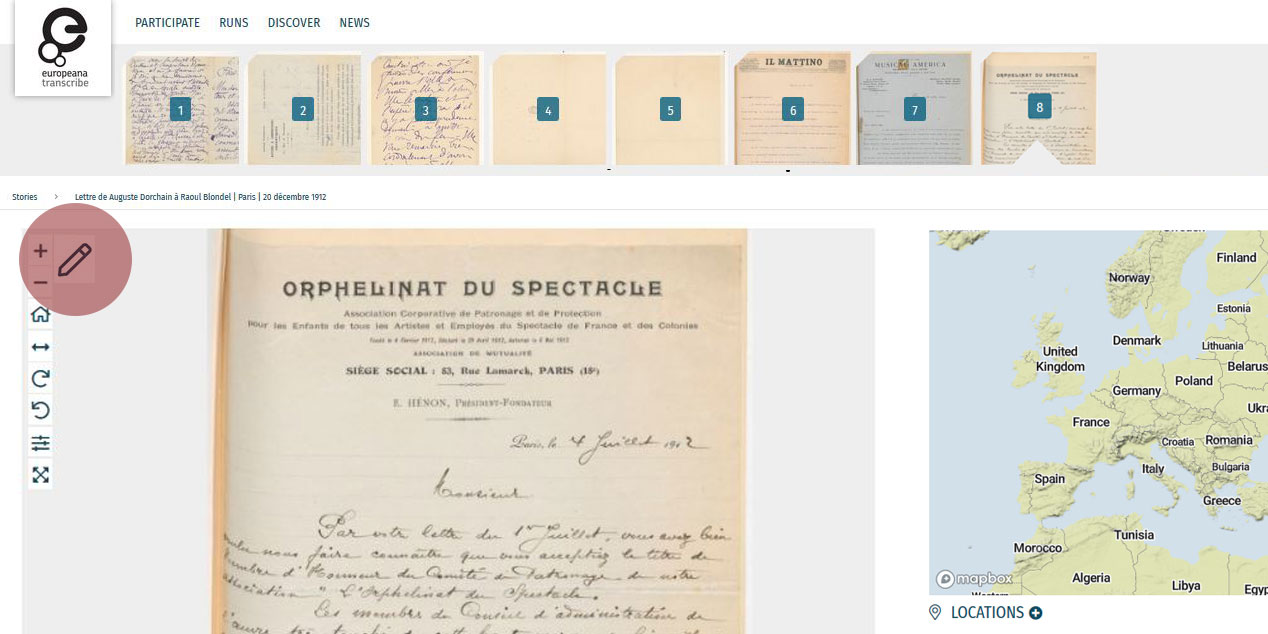
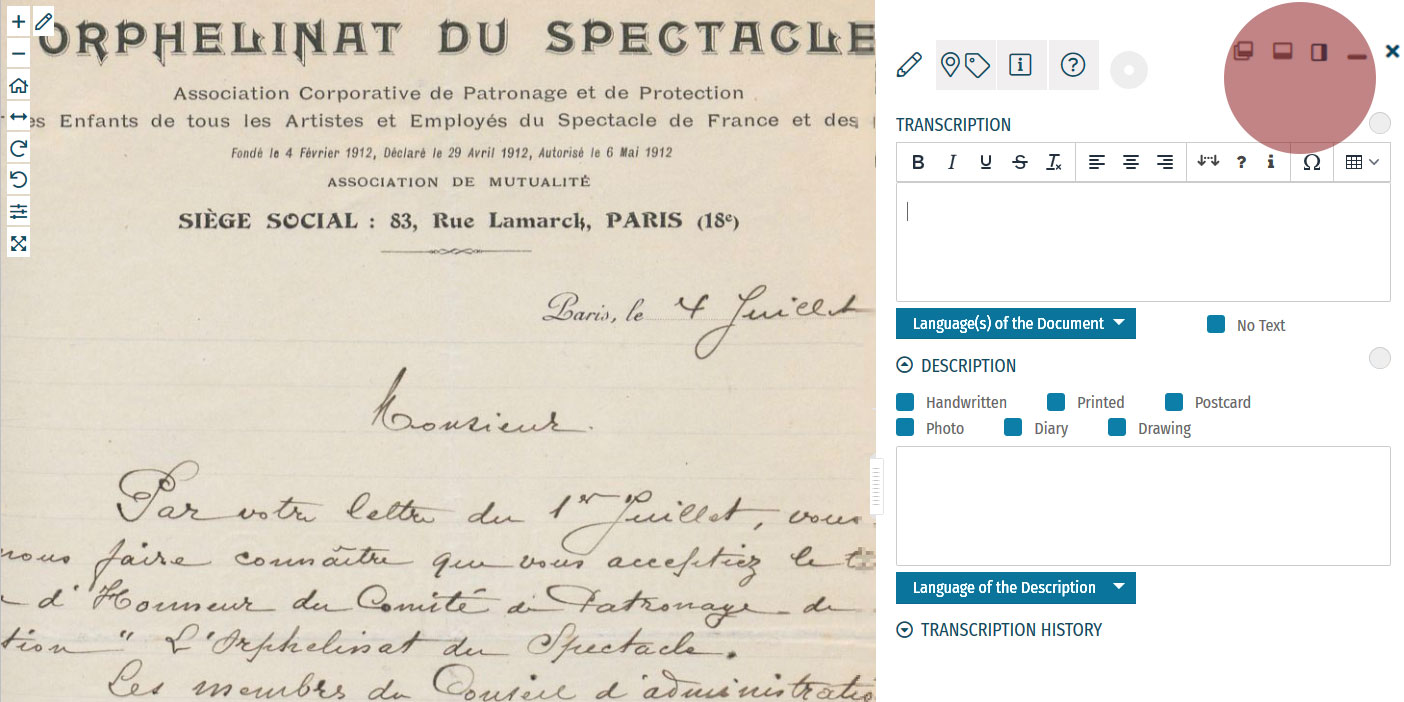
Enrichment Mode
Edit your workspace view by using the top-right menu.
You can have the white Activity Panel docked to the right (default) , to the bottom , or as an independent overlay . If you just want to view the image, you can hide the panel using the minimise button , and then re-open it with the pen button. Adjust the size and position of your Activity Panel according to your preferences.
You enrich documents by following a step-by-step process.
Make sure you regularly save your enrichments in each step to avoid the risk of losing your work.
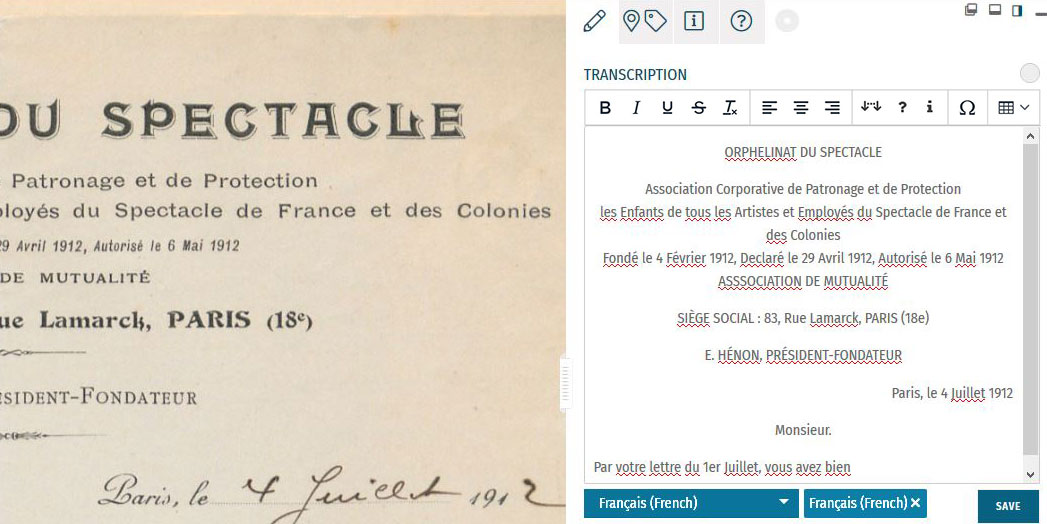
Step 1: Transcription
To start a transcription, select the transcription tab at the top menu of the Activity Panel. Click inside the box underneath the heading TRANSCRIPTION and start writing your transcription. When needed, use the toolbar to format your text and to add special characters and tables. A guide to the transcription toolbar is available in the Formatting section of this tutorial.
Identify the language(s) of the text using the dropdown list under the transcription box. You can select multiple languages at once.
If the item has no text to transcribe, tick the checkbox ‘No Text’.
Once you have finished your transcription, click SAVE.
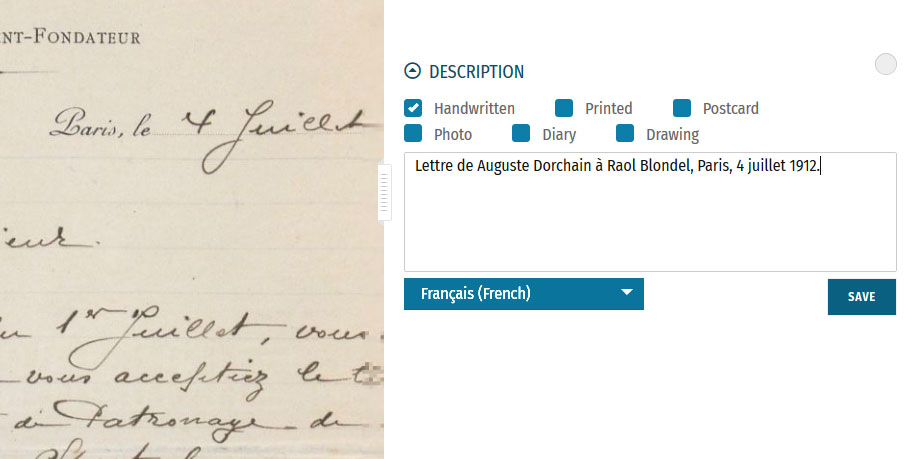
Step 2: Description
You can add a description to the item underneath the Transcription section.
The first task is to identify what type of document the item is: a handwritten or printed document, a postcard, photo, drawing and/or part of a diary. Tick the category which best applies to the item. Multiple categories can be selected at once.
The second task is to write a description of the contents. Click inside the box underneath the heading DESCRIPTION. Here, you can write what the item is, what it is about, and specify the images and objects that appear in the item.
Identify the language of the description text that you wrote using the dropdown list underneath. You can only select one language.
Once you have finished your description, click SAVE.
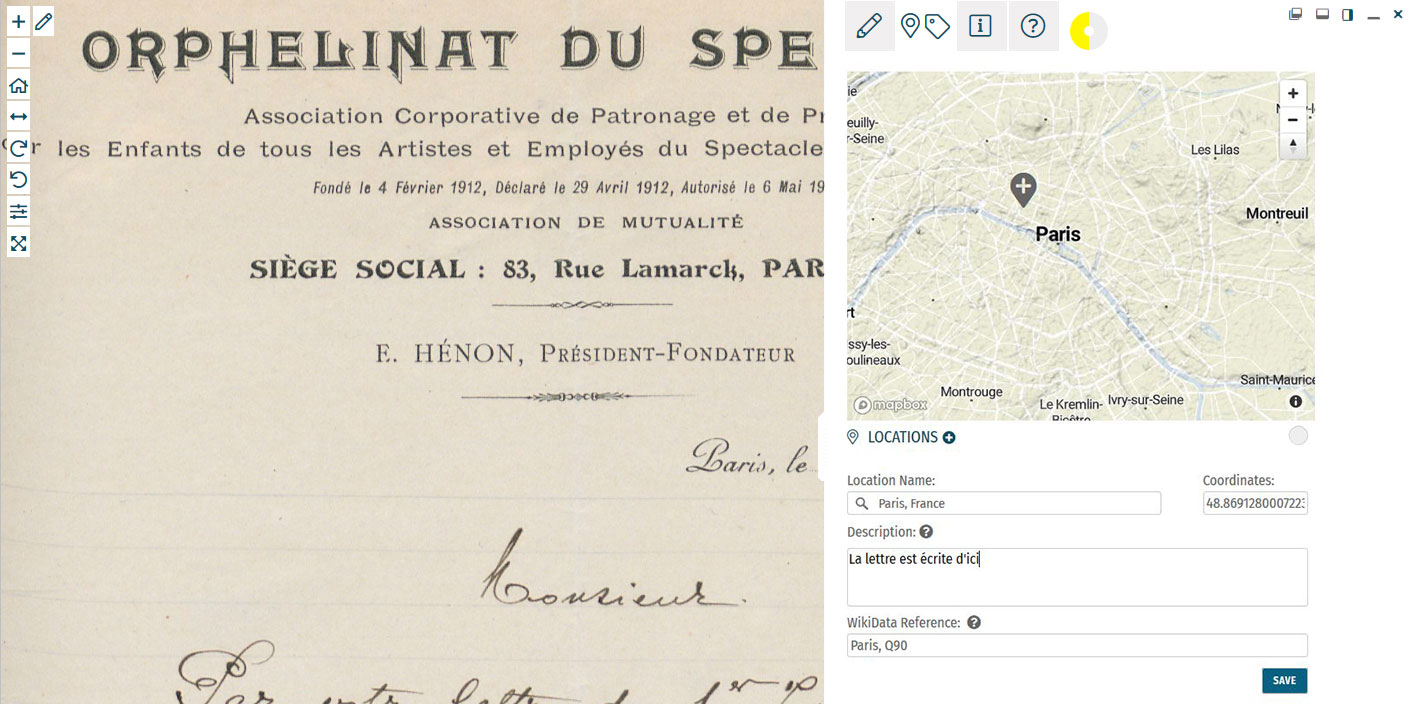
Step 3: Location
If you find a location mentioned or recognise a place in the item, you can create a geotag and pin it to the item map. Multiple locations can be attached to the item. To tag locations, select the tagging tab at the top menu of the Activity Panel. Click the plus next to the heading LOCATIONS. Type the location into the search bar and select the result that best applies. A new pin will be placed into the map. The location name should be a clear georeference, e.g. a country, city or address. Make adjustments to the location name if necessary. You can also adjust the position of the pin by dragging it on the map. If you want to add further details to the location, you can write a (short) description. This could include extra information about the geotag (e.g. the building name or a significant event that took place at the location) or the relevance of the place to the item (e.g. the hometown of the author). You can also add a Wikidata reference to link the location to a stable source. Search for the reference using the Wikidata fields. Once you have finished your location tag, click SAVE. You can find the place(s) tagged to the item in grey at the bottom of the Location(s) section.Step 4: Tagging
Below the Locations section is the Tagging section, where you can add the following annotations:
 Document Date:
Document Date:Here, you can add dates that correspond to the item. This could include the dates mentioned in the text (e.g. in diary pages), the date of a related historical event (e.g. the end of WWI), or when the item was created (e.g. from a dated signature on an illustration). You can either define this as a single date or as a longer time frame.
To tag dates to the item, write the start and end dates in DD/MM/YYYY format in the fields or select the dates by clicking on the calendar.
If you only have one date to add, insert the same date into both start and end fields.
If you don’t know the exact days, you can also tag the date on the scale of months (MM/YYYY) or years (YYYY).
Once you have finished your date tag, click SAVE DATE.
 People:
People:People mentioned as creators or subjects in the item can also be tagged. Depending on the information you might have, you can enter the person’s first and last names, as well as their dates of birth and death. There is also the option to write a short description of the person, explaining who they are or their relevance to the item, e.g. the person’s occupation or their relation to another tagged person.
Multiple people can be tagged to one item.
Once you have finished your person tag, click SAVE.
 Keywords:
Keywords:Here, you can freely add keywords related to the topic and content of the item. This could include particular themes (e.g. art, music, war), subjects (e.g. children, cooking, France), or particular historical affiliations (e.g. 20th century, Austro-Hungarian Empire, Fall of the Iron Curtain).
Multiple keywords can be added and they can be written in any language.
Write your keyword tag into the field and click SAVE.
 Other Sources:
Other Sources:External websites with information about the item’s content can be linked here. This could include links to further data about a person mentioned, a particular historical event or links to digital versions of newspapers that appear in photos or clippings in a notebook.
To add a link, click the plus next to the heading ‘Other Sources’. Enter the URL into the Link field, and write a short description of this link in the Additional Description field.
Multiple links can be tagged to one item.
Once you have finished your tag, click SAVE.
Step 5: Mark for Review
Once you have saved your contribution, the task will automatically change to the Edit status. If you think the task is finished, you can mark it for review. Note that you have to be at Runner level or above to do this (see: Miles and Levels). Click on the yellow circle next to the section heading and select Review in the list that appears. The task now needs to go under Review by another volunteer.Formatting
Review
 All enrichments need to be edited and reviewed by more than one volunteer to ensure that they are as accurate as possible.
Only Sprinters and Champions can edit tasks in the Review stage and mark them as Complete. (see: Miles and Levels)
You can review a task (Transcription, Description, Locations, or Tagging) when the circle next to the heading is coloured orange .
During the review process, pay close attention to the following requirements:
All enrichments need to be edited and reviewed by more than one volunteer to ensure that they are as accurate as possible.
Only Sprinters and Champions can edit tasks in the Review stage and mark them as Complete. (see: Miles and Levels)
You can review a task (Transcription, Description, Locations, or Tagging) when the circle next to the heading is coloured orange .
During the review process, pay close attention to the following requirements:
-
- Transcription: The complete text in the item has been properly transcribed and the transcription is formatted as accurately as possible. The correct language(s) are selected and the transcription contains no missing or unclear icons.
-
- Description: The description is accurate and detailed (especially items without text to transcribe, e.g. photos), and the appropriate categories have been ticked.
-
- Location(s): All locations have been correctly tagged. The location name is accurate and matches the coordinates and the pin on the map. The description is clear and concise, and the Wikidata reference (if any) is correct.
-
- Tagging: Document dates are completed and as precise as possible. All mentioned people are tagged and their data is correct. All added keywords are applicable to the item, and other sources have accurate information and functioning links.
Completion Statuses
| GREY |
| 1. NOT STARTED |
| Tasks have not been started. |
| YELLOW |
| 2. EDIT MODE |
| Tasks have been started, but not yet finished. Additions and edits can still be made. |
| ORANGE |
| 3. REVIEW |
| Tasks are finished, but need final review by Sprinter or Champion transcribers. |
| GREEN |
| 4. COMPLETED |
| Tasks have been fully completed and reviewed. No further changes need to be made. |
Miles and Levels
Transcribathon is a competitive marathon. You do not enrich documents alone, but compete and work with other volunteers to ensure the quality of your work. When you first create a Transcribathon account, you only have the ability to start and edit tasks. The more you enrich documents, the closer you become to advancing to a higher level, which can unlock abilities like reviewing and completing tasks.| Level | Abilities |
|---|---|
| Trainee | Basic abilities: start and edit tasks |
| Runner | Basic abilities, mark finished tasks for review |
| Sprinter | All Runner abilities, mark reviewed annotations as completed |
| Champion | All Sprinter abilities, mark reviewed transcriptions as completed |
| Tasks | Miles Received |
|---|---|
| Transcription | 1 Mile for every 300 characters transcribed |
| Description | 1 Mile for every 5 Descriptions added |
| Location | 1 Mile for every 5 Locations added |
| Tagging | 1 Mile for every 5 Tags added |
| Reviewing | 1 Mile for every 10 items marked as complete |
